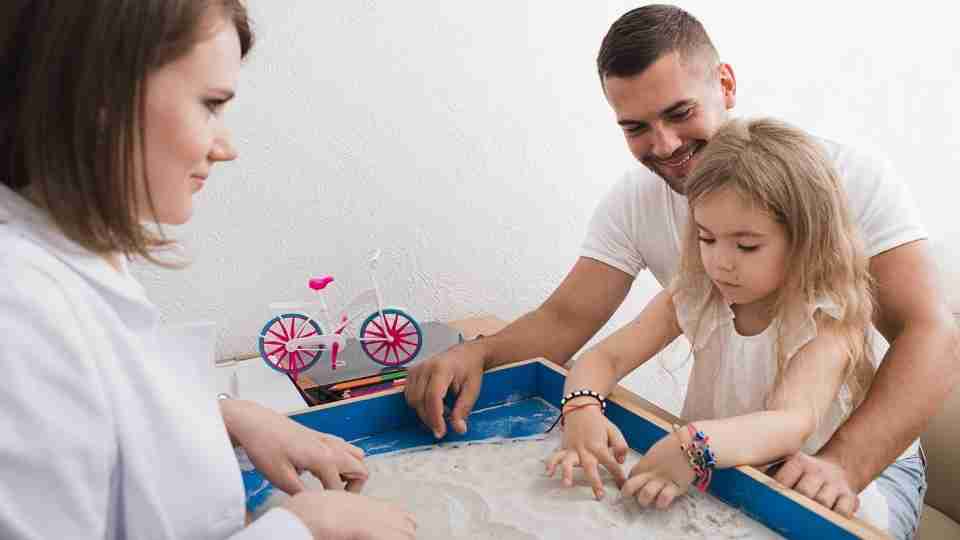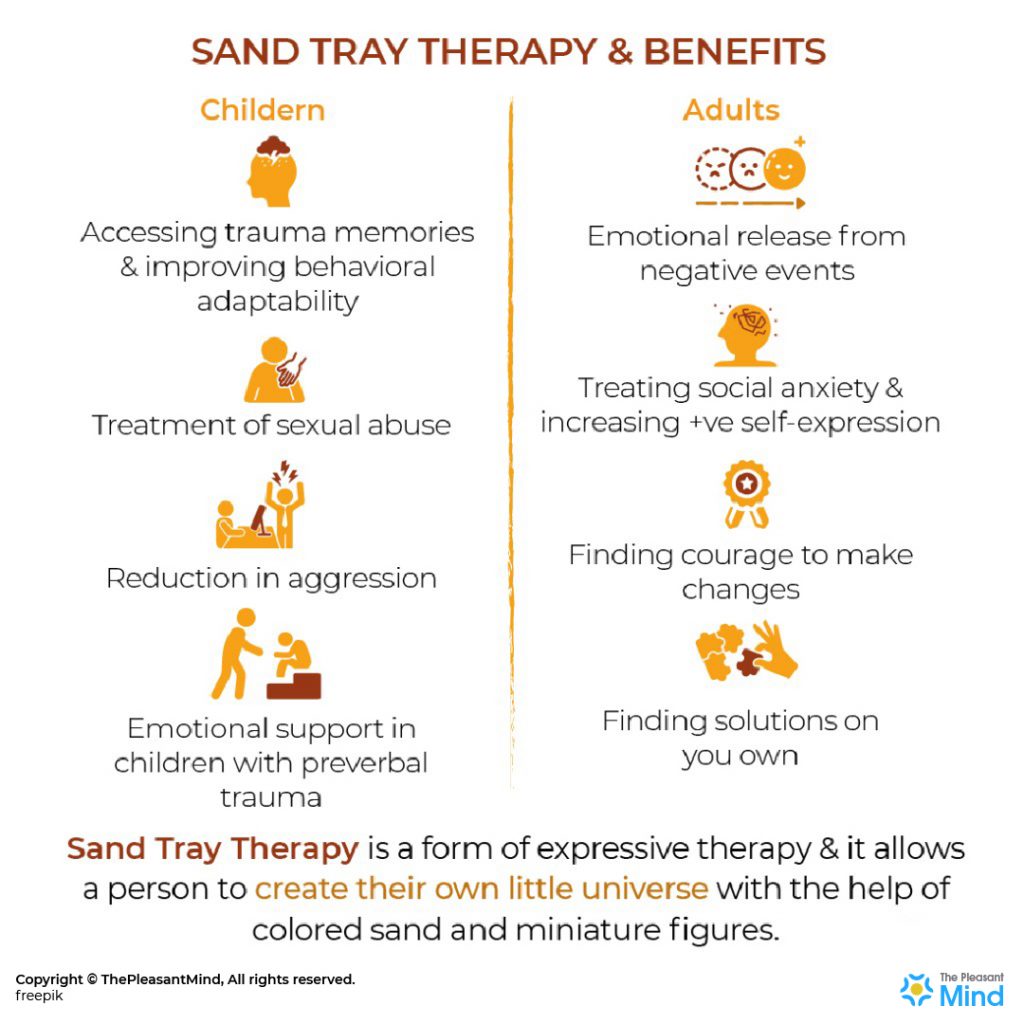
Often the hands will solve a mystery that the intellect has struggled with in vain.
— Carl Jung
This is the core principle of Sand Tray Therapy.
We are rushing into the next decade with even more complications and anxieties than the previous one. As a result, we need to find peace and calm amidst the chaos.
One of the best ways to do this is to connect with our inner, symbolic world in a more meaningful way. Sand Tray Therapy provides us an opportunity to do the same.
It was first popularized as a therapeutic technique by Margaret Lowenfeld, a British pediatrician. Psychotherapists initially used Sand Tray Therapy only to treat children.
Later, it gained popularity as a powerful tool for counseling, teens, adults, families, couples, and groups alike.
Sand Tray Therapy Infographic

What is Sand Tray Therapy?
Also known as Sand Play Therapy, it is a form of expressive therapy. It allows a person to create their own little universe with the help of colored sand and miniature figures. These scenes act as a reflection of a person’s life.
They offer them an opportunity to solve conflicts, gain higher self-esteem, and learn how to get past hurdles if any.
Ever since its inception, psychotherapists are using Tray Therapy for assessing, diagnosing, and treating mental illnesses. Therapists often use it for counseling people who have been abuse victims or have experienced trauma.
Sand Tray Therapists aim to use this technique for helping patients increase emotional expression and decrease psychological distress.
History of Sand Tray Therapy
SUMMARY
Margaret Lowenfeld introduced this approach to child psychotherapy. She called it the World Technique. Dora Kalff integrated it with other treatment modalities.
Margaret Lowenfeld first came across the idea while reading Floor Games. It is a book written by HG Wells in 1911. It describes the adventures of Wells and his sons playing on the floor. Wells describes sandbox games as a means of personal development for children as well as parents.
Lowenfeld entered child psychotherapy in 1928. She established the Institute of Child Psychology in London in the early 1930s. Then, she introduced a sandbox in the children’s playroom and kept small toys and other trinkets near the box.
She noticed that the children soon started referring to the sandbox as the ‘world.’ They were creating three-dimensional scenes in the sandbox using miniature figures and other items. Lowenfeld called this approach the World Technique.
She stated that it acts as a tool for communication between the child and the therapist. Dora Kalff then learned the World Technique. She came to study under Lowenfeld.
Eventually, she combined the technique with Eastern philosophy Carl Jung’s individuation theory and Neuman’s system model. She called it Sand Play Therapy.
How Does it Work?
SUMMARY
Sand Tray Therapy involves patients finding answers to their problems. It involves using mini-figures to represent the inner world.
Sandplay therapists use a combination of play therapy, art therapy, verbal therapy, and other types of techniques. A box filled with sand is provided to the patient, along with several miniature toys to create a ‘world.’
The toys may include anything – people, animals, vehicles, buildings, trees, etc.
As the patient creates the world, the therapist acts as an observer. Patients can use whichever figures they want. They can arrange them in whatever way they want. After the session is over, the therapist discusses what he or she observed.
The discussion includes – which figures the patients chose, and how he/she arranges them. It is also discussed what their meaning might be. After the discussion, the patient can rearrange the toys based on the talk.
This technique allows the patient to seek clarity and answers to their struggles on their own. The sand acts as a tool for healing and is patients can use it as a creative expression.
People who are unable to express themselves in traditional therapy or cannot vocalize their problems seem to benefit immensely from this technique.
CAUTION
The microcosm created in the sand may not make immediate sense to the patient. It’s the therapists’ job to aid them in this process and find the connection between the ‘sand world’ and their inner world.
Sand Tray Therapy for Children
SUMMARY
Sand Tray Therapy helps children access trauma memories and improve behavioral adaptability. It can also help heal them heal after sexual abuse, reduce aggression, and treat preverbal trauma.
There are many benefits of using Sand Tray Therapy in children:
1. Accessing trauma memories and improving behavioral adaptability
Often, children find it difficult to verbalize their emotional state. This is especially true if they have suffered trauma, abuse, or neglect. Sand Play Therapy is primarily nonverbal and allows the use of a familiar medium, that is, sand.
Therefore, it can help children express themselves in a secure and comfortable manner. Children generally display a tendency for independent play. They tend to use their own expressions for explaining certain situations.
Sand Play Therapists make use of this aspect in therapy. They observe as the children display behavioral changes without any cues or directions.
This allows the therapist to gain access to traumatic memories in a way that does not retraumatize the children. The method also acts as a powerful outlet for children. They can express their feelings comfortably in this way.
After witnessing traumatic events, children can find it difficult to adapt to their environment. Sand Tray Therapy can help in this regard too. This study was conducted on 3 children who witnessed domestic violence in the Republic of Korea.
It involved using a combination of music, imagery, and sand play to help the children improve emotional and behavioral adaptability.
After six sessions of Sand Tray Therapy, researchers observed that there was a significant effect on the children’s ability to express themselves and their emotions.
2. Treatment of sexual abuse
Children who have suffered sexual abuse are often withdrawn and non-interactive. They remain silent for fear of harm or worse, death. Due to their traumatic history, they often feel threatened by adults. They also remain in a highly anxious state during therapy.
Sand Play Therapy is relaxed, familiar, and interactive without any verbal cues. It provides them the initial feeling of safety that they need in order to start the healing process.
3. Reduction in Aggression
This study was conducted to see if children who struggle with externalizing behavior benefit from Sand Play Therapy.
Children of ages 4-5 years received 30 minutes of therapy twice a week. After a total of 16 sessions, they showed a reduction in aggression. There was also a significant fall in the number of negative peer interactions.
Thus, sand play therapy programs can be extremely helpful in childcare centers.
4. Emotional Support in Children with Preverbal Trauma
This study focuses on finding the benefits of Sand Tray therapy in supporting a child with language barriers. The 3-year old, Sotho-speaking child was infected with the Human Immunodeficiency Virus (HIV) and suffered from Acquired Immune Deficiency Syndrome (AIDS).
The child underwent 18 sessions of Sand Play Therapy. It was seen that the approach is extremely helpful in bridging the language barrier. The child’s emotional, social and interactive behavior improved exponentially during the sessions.
Thus, the technique may be helpful in treating children who suffer from pre-verbal trauma and are vulnerable.
TIP
Preverbal trauma refers to vulnerable children who are too young to effectively articulate their experiences and talk about traumatic events.
Sand Tray Therapy for Adults
SUMMARY
Sand Tray Therapy can help adults release negative emotions, and increase positive self-expression. It can also help them make necessary changes to their lifestyle, and find solutions to their problems.
Undoubtedly, Sand Tray Therapy looks like child’s play. But the simplicity of the technique should not be mistaken for ineffectiveness. It is a highly therapeutic method that has multidimensional benefits for adults as well.
1. Emotional Release from Negative Events
People who do not show a good response to other therapy tools may find this approach effective. The hands-on method used in this technique provides emotional release from trauma and abuse. The simplistic environment allows the patient to feel safe from threats.
2. Treating Social Anxiety and Increasing Positive Self-Expression
A study was conducted to understand the effects of Sand Tray Therapy on relieving social anxiety in migrant women in South Korea.
There was a sudden increase in the number of multicultural marriages in the country. The negative effects of the social phenomenon were seen in women who immigrated here.
It was found that group sessions of Sand Play Therapy can help reduce negative emotions related to migrating to a foreign country. It was also observed that these women had reduced levels of anxiety.
They also showed decreased negative self-expression and did not feel lonely anymore.
3. Finding the Courage to Make Changes
The Sandplay therapists work with the patient to understand the metaphorical meanings behind the positioning of the miniature figures.
The patient then alters their location to represent real situations and people. As they make changes in the make-believe world, they may also find the courage to do the same in their life.
4. Finding Solutions on Your Own
The sandbox and mini toys help the patient create a world that reflects their internal struggles, problems, and conflicts. Rearranging the toys allows them to find solutions to these problems on their own, with little to no help from the therapist.
TIP
The therapy involves recreating real-life situations in the sandbox for months or years to see any significant changes. However, patients have also reported experiencing real change after just one session.
Limitations of Sand Tray Therapy
SUMMARY
The therapy may be confusing and time-consuming. It relies heavily on the expertise of the therapist. Adults may find it difficult to be artistically expressive. There is not enough data to validate the technique.
Like all other treatment modalities, there are certain limitations to Sand Tray Therapy:
- Some communities see this approach as confusing and frustrating. People may complain that it is too time-consuming or intrusive.
- Sand Tray Therapy relies on the clinical expertise of the therapist to a large extent. This may not seem favorable to some patients.
- Adults may find it too difficult to take this visually expressive approach. This is because most adults think they lack creativity and artistic skills.
- The mental health community has not arrived at a consensus when it comes to the interpretation of the sand pictures. Some of the explanations may be seen as too vague or ambiguous. They can also contribute to a complete disregard of other explanations.
- Even though the core principle is grounded in scientific theory, the clinical data is not enough to provide concrete validation to this technique.
Finding a Sand Tray Therapist
Although any therapist can provide Sand Tray Therapy, it is better to find a certified expert. The US government does not provide any certifications for this method. However, there are other certification bodies. You can find the experts on the directory offered by Sandplay Therapists of America.
You can also start looking for a professional therapist in your area by consulting your physician.
Article Sources
1. https://www.psychologytoday.com/us/therapy-types/sandplay-therapy
2. https://psychcentral.com/health/sand-tray-therapy
3. https://www.themeadows.com/blog/sand-tray-therapy-what-is-it-and-how-does-it-work/
Are you interested to know more about ‘Ajna Light Therapy’ then click here?
Surabhi has a deep passion for words. She puts her heart and mind into whatever she pursues and craves for creative ventures. She has always been keen on creating original content that can make a difference. In her experience as a content writer, she has had the opportunity to work on several fields with Psychology being her favorite. Surabhi says, words have the power to transform the world, better than a sword. So she hopes to contribute her bit to this revolution. At ThePleasantConversation, she feels lucky to have the opportunity to share content capable of bringing about a change in the lives of the readers.